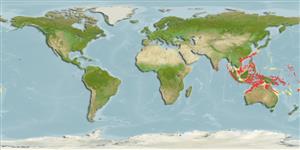>
Perciformes/Serranoidei (Groupers) >
Epinephelidae (Groupers)
Etymology: Epinephelus: Greek, epinephelos = cloudy (Ref. 45335); kupangensis: Name from Latin suffix '-ensis', denoting place or locality, is appended to the locality of Kupang, Indonesia, the center of the Timor Sea fishery that provided the first author with the holotype and several paratypes..
Environment: milieu / climate zone / depth range / distribution range
Ecologia
marinhas associadas(os) a recifes; intervalo de profundidade 50 - 300 m (Ref. 111063). Tropical
Indo-West Pacific: Indonesia (Timor Sea), Timor-Leste, Philippines, Taiwan, and Fiji.
Tamanho / Peso / Idade
Maturity: Lm ? range ? - ? cm
Max length : 39.1 cm SL macho/indeterminado; (Ref. 111063)
Descrição suscinta
Chaves de identificação | Morfologia | Morfometria
Espinhos dorsais (total) : 11; Raios dorsais (total) : 15 - 17; Espinhos anais: 3; Raios anais : 8. This species is distinguished from its Indo-Pacific congeners by having the following characters: lateral line scales 46-49 (vs. at least 51 in all species except E. areolatus, E.
bilobatus, E. bleekeri, E. bontoides, E. chlorostigma, E. faveatus, E. howlandi, E. longispinis, E. macrospilos, E. maculatus, E. merra, E. miliaris, E. polyphekadion, E. quoyanus, E. timorensis, E. trimaculatus), round caudal fin (vs. emarginate to truncate caudal fin in E. areolatus, E. bleekeri, E. chlorostigma, E. geoffroyi, E. timorensis), no distinct spots over most of head and body (vs. numerous distinct spots - not dots - over most of head and body in E. bilobatus, E. bontoides, E. faveatus, E. howlandi, E. longispinis, E. macrospilos, E. maculatus, E. merra, E. miliaris, E. polyphekadion, E. quoyanus, E. trimaculatus) (Ref. 111063).
This fish is part of a large, deep-water drop line fishery, which focuses its efforts on banks and promontories of shelf habitat in depths of up to 350 m (Ref. 111063).
Ciclo de vida ou comportamento de acasalamento
Maturities | Reprodução | Spawnings | Egg(s) | Fecundities | Larvas
Tucker, S.J., E.M. Kurniasih and M.T. Craig, 2016. A new species of grouper (Epinephelus; Epinephelidae) from the Indo-Pacific. Copeia 104(3):658-662. (Ref. 111063)
Status na Lista Vermelha da UICN (Ref. 130435)
Ameaça para os humanos
Harmless
Uso pelos humanos
Ferramentas
Relatórios especiais
Baixar XML
Fontes da internet
Estimates based on models
Índice de diversidade filogenética (Ref.
82804): PD
50 = 0.5000 [Uniqueness, from 0.5 = low to 2.0 = high].
Bayesian length-weight: a=0.01175 (0.00571 - 0.02419), b=3.04 (2.88 - 3.20), in cm total length, based on LWR estimates for this Genus-body shape (Ref.
93245).
Nível Trófico (Ref.
69278): 3.8 ±0.6 se; based on size and trophs of closest relatives
Resiliência (Ref.
120179): médio(a), tempo mínimo de duplicação da população 1,4 - 4,4 anos (Preliminary K or Fecundity.).
Fishing Vulnerability (Ref.
59153): Moderate vulnerability (38 of 100).
